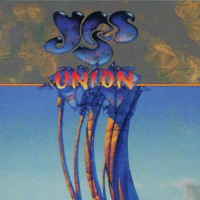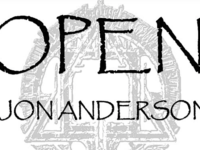Jon Anderson stopped by before embarking on a new solo tour of Australia and New Zealand to discuss a few key moments from his career — including key Yes tracks from Close to the Edge and The Yes Album.
In an exclusive Something Else! Sitdown, Anderson talks at length about working with former Yes bandmates Rick Wakeman and Tony Kaye. His musical relationship with Wakeman, who was a part of Yes over three stints between 1971-97, continues into this decade, with The Living Tree studio album and tour.
We also take a look back at his time with Peter Banks, who passed earlier this month, and Jon Anderson makes his selection for the most overlooked project in Yes’ storied career — the largely dismissed 1994 project Talk, which would be the last to feature Kaye and Trevor Rabin …
“AND YOU AND I,” CLOSE TO THE EDGE (1972): An episodic wonder, this track begins with the sound of Steve Howe tuning his guitar then moves through a series of movements highlighted by Rick Wakeman’s work on both Moog and Mellotron during the subsequent “Eclipse” and then a neo-Wagnerian segment, before Jon Anderson returns with a mantra-like repetition of a quartet of lines from the initial “Cord of Life.” (“Eclipse” was sampled out for a single, and went to No. 42.) Anderson tells us that this period, for him, still represents Yes at the peak of its powers.
JON ANDERSON: You listen to any band, and they go through highs and lows. That was a serious high. It was music that had never been tried before. It will be tried again, though, in the coming 10 or 20 years. People will expand their musical horizons, because they’re not being engaged by the radio or the record companies. That’s a thing of the past, in many ways.
“23/24/11,” THE LIVING TREE (2010): An emotional centerpoint of Jon Anderson’s nine-track duo recording with Wakeman, “23/24/11” is told from the perspective of a soldier who’s counting every moment until he is allowed to come home again. By taking us on a visceral journey into the horrors of war, the pair drive home their central question: Why does this kind of violence remain a part of our lives? Avoiding the epic constructions of yesteryear, “23/24/11” instead showcases a delicate, shaded and yet very direct performances from both Anderson and Wakeman. Their connection, Anderson tells us, was immediate — from the day the keyboardist became a part of Yes, just before 1971’s Fragile.
JON ANDERSON: When Rick joined, he was already working with five or six keyboards then. We now had all of these sounds, and his technique was amazing. It was a very joyful experience, that first couple of years when we were together — I think because we were all in this sort of harmony place. It’s a very rare happening. For most bands, you go through that period where you are very much in harmony — for a short period of time — and you make really great albums. Then, the band fizzles out, or whatever. Yes seemed to have these harmonic energies, every now and again, and with Rick, it was always very special.
“ASTRAL TRAVELLER,” TIME AND WORD (1970): When Banks passed away on March 7, 2013, he left behind a criminally underappreciated legacy in music — as a solo artist, a member of Flash and Empire and, maybe most surprising, as the original guitarist in Yes. Many fans remain unfamiliar with the band’s pre-Steve Howe era, even today, and “Astral Traveller” is a terrific place to start that process of discovery. The track sets a template for much of what the band would become, right down to its forward-thinking title, and also includes one of Banks’ most completely realized solos with Yes. He and Jon Anderson famously clashed over the use of orchestration on this album, and Banks was summarily fired, but those bad feelings were long gone by the time of the guitarist’s death at just 65. Anderson released an official statement, recalling their time together in the band’s upstart early days …
JON ANDERSON: We played a show with the Who at the Marquee club in London early 1969. Peter talked about going on stage and smashing his guitar at the end of our set like Pete Townsend. He loved Pete, as we all did. I told him: “But you only have one guitar Peter. Pete Townsend has lots of ’em! Why not get a plastic guitar and smash that?” Of course, Peter found a dinky pink plastic guitar, and at the end of our set, he started smashing the little guitar to bits — and it wouldn’t smash right away, but he kept on bashing until it broke into tiny bits. It was one of the funniest moments of my life. Good old Peter. Bless him.
“I’VE SEEN ALL GOOD PEOPLE,” THE YES ALBUM (1971): Organist Tony Kaye, who would have a pair of stints with Yes, makes a towering contribution to the outro of this legendary song — adding a sense of anthematic glory as Jon Anderson and Co. repeat its chorus over and over. Composed by Anderson with bassist Chris Squire, the initial segment of the two-movement “I’ve Seen All Good People” was released as a single, reaching No. 40. But Kaye’s focus on the Hammond B-3, Anderson tells us, would ultimately lead to his initial departure in 1971, as Yes set a more adventurous course. Kaye would return, of course, for a second, far more commercially successful stint between 1983-95.
JON ANDERSON: Tony Kaye was amazing over the first three albums. It was just a question of having someone in the band who was willing to try different keyboard sounds. Tony was very: “I want to play the piano and the organ; that’s my thing.” When we tried to push him into different sounds, he wasn’t really eager to do it. You don’t want to force anybody to do anything.
“ENDLESS DREAM,” TALK (1994): Asked to name his most underrated project, Jon Anderson immediately pointed us toward this album — which featured Yes’ return to episodic compositions on “Endless Dream,” a track that reconnects with the band’s artistic triumphs of the 1970s. In fact, Yes hadn’t done such long-form work since “Machine Messiah” on 1980’s Drama. The song begins with the “Silent Spring” instrumental opening, before moving on to a 12-minute second movement which gave the album its name, and then concluding with Anderson’s meditative return to the “Talk” refrain for the closing “Endless Dream” segment. The sad fate of Talk, however, is bound up in bad timing, a record label teetering on financial ruin, and a fruitless search to replicate Yes’ earlier chart-topping hit “Owner of a Lonely Heart.”
JON ANDERSON: Talk is a really good album. But the record company went bankrupt, and it was very, very badly managed as an album. In those days, it was a question of making of making good music, so much as making a hit record again after 90125. Big Generator just didn’t happen. It was overblown, and overdone. I really had no part in that project; I just went in and sang. They wanted to keep me out of the way, so I went and did an album with Vangelis. I kept myself busy. But then after that, I did Anderson Bruford Wakeman Howe — and then got a really good energy with the record company at that time. They just wanted me to do what I wanted to do. With Steve and (original Yes drummer) Bill (Bruford) and Rick, it was so easy, because they just wanted to make music. So, the album worked. Then the next step was, we all got together, of course, and did Union and then me and Trevor started to really bond at that time. We hadn’t really bonded before, so it was real interesting time. Trevor asked if I would come stay at the house, and work on some music — and that became Talk. The album ended up having so much of the classic style of Yes, and that’s something very unique about it. But the record company went bankrupt, and the album never got any promotion — so, it was on the next project.
- Nick DeRiso’s Best of 2015 (Rock + Pop): Death Cab for Cutie, Joe Jackson, Toto + Others - January 18, 2016
- Nick DeRiso’s Best of 2015 (Blues, Jazz + R&B): Boz Scaggs, Gavin Harrison, Alabama Shakes - January 10, 2016
- Nick DeRiso’s Best of 2015 (Reissues + Live): John Oates, Led Zeppelin, Yes, Faces + others - January 7, 2016





Went to Jon Anderson’s wonderful solo concert last night in Brisbane, Australia. Surreal & magical night of witnessing one of the great singer songwriters. Interesting story’s from his past, a superb evening of superb songs. He is Yes, we all know that without him, they would have been nothing! Brilliant 2 hours indeed!
I LOVED Talk. Endless dream is brilliant. Jon Anderson and Yes define the concept of the “Opus”. I thank Jon for turning me on to Tori Amos.
The main difference between Tony Kaye’s work with YES early on and his return stint was that there were no additional keyboardists hidden under the stage to make him look good the first time around.
Jon Anderson should work with Jimmy Page and try to sing hard rock more often. I agree with Beenecounter that “Endless Dream” is something special. Jon Anderson is a spiritual man, his contribution is eternal.